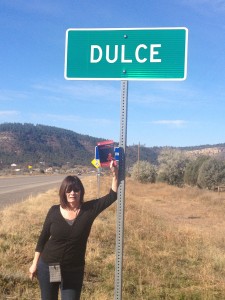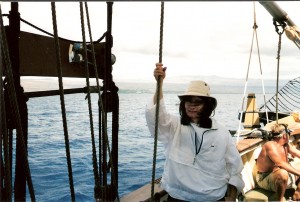Character, plot, and setting. These are the three main building blocks of fiction. What connects these three components and brings them to life are the details.
But which details do we include in our stories?
In this photo taken several years ago, I’m aboard the Maine-built Lynx, a clipper schooner inspired by the 1812 American Privateer Lynx, built in Fells Point, Maryland, my home state. Here we are on an afternoon sail, just outside of Kawaihae Harbor, on Hawaii Island. (Consider the details in these two sentences: perhaps too many? Or, irrelevant? Does the reader really want or need to know where I was born? Do they care the replica vessel was built in Maine? Is that important to my story? Does it give the ship life?)
So many details, so many components, can be discovered in this single photograph. Hemp lines, sun-bleached blocks, and the polished wood rail. There’s the sweaty, sunburned, bare-chested man behind. There’s the soft Kona breeze against my hair and the side of my face….the rough scratch of hemp against my bare hand on the brace. The creaking of blocks, the swish against the hull as the ship makes way through the water. I am feeling too warm under the white cotton jacket I wear to protect my skin from the sun. And although I look confident, I’m fighting a feeling of queasiness – a rolling of the stomach that coincides with the roll of the ship on the ever-present swell.
Which of these descriptions brings the story to life?
Typically, when I write the first draft of a story, I don’t include all the details. The first time through I hear conversation, I hear interior thoughts. I write what happens to the characters – the plot. What I end up with is little more than a narrative outline of the story – with dialogue and motivation. It’s only on subsequent drafts that I go back and get inside each scene, page by page, using my memory and imagination – and often research – to flesh out the details.
Once I really get inside the scene, it’s easier to experience the details. I ask myself, what am I seeing, hearing, tasting, smelling, feeling? What am I wearing? What kind of day, or night, is it? What is going on in the larger world at that time and place, that affects me? What phase was the moon in?
Seriously, moon phases for past dates, can be worked out! Tables exist! When I wrote Star-Crossed I became obsessed with moon phases; I wanted to know when the moon was full. My scientist husband researched this for me, God love him! Does historical fiction need to be that exact? No! But I was absorbed with that detail.
In my contemporary fiction as well as my historical fiction, I like to visit the places I’m writing about, whenever possible. Often the setting itself initiates the story. I record details in photographs, in a journal, and sometimes on random scraps of paper. I read books and first-hand accounts about the places and events in my story. I listen to music associated with the time period and even dress like my protagonist. Method writing!
After I pile on the descriptions, later revisions involve cutting out extraneous detail and searching for more poignant description. Characters can drown in too much setting. Too many props distract. But how does a writer know which details to cut? That’s where the art of writing, rather than the craft comes in. And voice. We could all write the same plot with the same characters, yet it wouldn’t be the same story at all. What we choose to describe, the details we include, are part of our perspective. Our voice.
Writing exercise: Take five minutes to describe the place where you are right now. Using your five senses, explore your surroundings in minute detail. Include your feelings. You can easily come up with a wealth of information, almost a list, on the page. The challenge for the author is choosing the telling detail. Which single detail or description brings your scene to life? Which one brings a vivid image or sensory experience to mind? Consider cutting the others to make that one stand out. This is a decision only the author can make.
 Here’s a passage from Looking for Redfeather (pg. 53) that shows what details I felt were important:
Here’s a passage from Looking for Redfeather (pg. 53) that shows what details I felt were important:
The blast of cool air felt refreshing against their skin, and the smell of bacon frying was tantalizing. Big, old-fashioned, over-stuffed booths, the bright color of taxi cabs. Eighties music filled the room. Foreigner singing, “I wanna know what love is” — that’s just how they felt! Lyrics and music composed and recorded long before they were born had been given new significance. Everything they saw and heard seemed important, meaningful, created for them alone.
“Breakfast is on me, my friends,” Chas said largely. “Have whatever you want.”
They took him at his word, ordering as if money were no object, as if they had just returned, triumphant, from a long and arduous journey. A wait person brought them coffee (a man or a woman, they weren’t sure), and they admired the sinewy arm, a panorama of ink from wrist to armpit. Chas felt like he was in some kind of spontaneous street performance and everyone they saw was a character.
Bacon — a pile of bacon, stacked like firewood — and has browns, steaming beneath the brown crust. Heaps of fluffy scrambled eggs, golden pancakes, stacks of buttered white toast. Ice tea, chocolate milk, orange juice, and coffee served in thick mugs, cracked from years of holding hot coffee, mugs that had touched how many lips? More coffee? Oh, yes, please, and Chas shoveled in the sugar, stirring the muddy slurry, appreciating for the first time how good coffee could be…
***
I guess I must’ve been hungry when I wrote that! The actual place that inspired that passage was Tom’s Diner on Colfax Avenue, Denver, Colorado.

